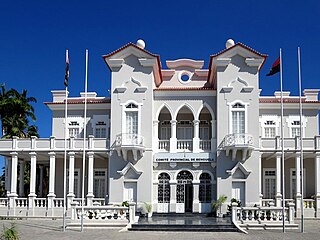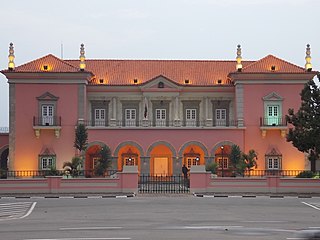 W
WAldeia Nova is a town and commune of Angola, located in the province of Cuanza Norte.
 W
WBenguela is a city in western Angola, capital of Benguela Province. Benguela is one of Angola's most populous cities with a population of 555,124 in the city and 561,775 in the municipality, at the 2014 census.
 W
WCabinda, also known as Chioua, is a city and a municipality located in the Cabinda Province, an exclave of Angola. Angolan sovereignty over Cabinda is disputed by the secessionist Republic of Cabinda. The city of Cabinda had a population of 550,000 and the municipality a population of 624,646, at the 2014 Census. The residents of the city are known as Cabindas or Fiotes. Cabinda, due to its proximity to rich oil reserves, serves as one of Angola's main oil ports.
 W
WCaxito is a town, with a population of 55,000 (2014), and a commune in the municipality of Dande, province of Bengo, Angola. It is also the capital of the Bengo province.
 W
WCuíto, formerly known as Silva Porto, is a city and municipality in central Angola, capital of Bié Province. The municipality had a population of 450,881 in 2014.
 W
WHuambo, formerly Nova Lisboa, is the third largest city in Angola, after the capital city Luanda and Lubango, with a population of 595,304 in the city and a population of 713,134 in the municipality of Huambo. The city is the capital of the province of Huambo and is located about 220 km E from Benguela and 600 km SE from Luanda. Huambo is a main hub on the Caminho de Ferro de Benguela (CFB), which runs from the port of Lobito to the Democratic Republic of the Congo's southernmost province, Katanga. Huambo is served by the Albano Machado Airport.
 W
WLuanda, is the capital and largest city in Angola. It is Angola's primary port, and its major industrial, cultural and urban centre. Located on Angola's northern Atlantic coast, Luanda is Angola's administrative centre, its chief seaport, and also the capital of the Luanda Province. Luanda and its metropolitan area is the most populous Portuguese-speaking capital city in the world, with over 8.3 million inhabitants in 2020.
 W
WLubango, formerly known as Sá da Bandeira, is a municipality in Angola, capital of the Huíla Province, with a population of 776,249. The city center has a population of 600,751 making it the second largest city in Angola after the capital city Luanda.
 W
WLucapa is a town, with a population of 110,000 and a municipality with a population of 154,305, located in eastern Angola. Lucapa is the former capital of Lunda Norte Province.
 W
WLuena, formerly known as Luso, is a city and municipality in eastern Angola, administrative capital of Moxico Province. The municipality had a population of 357,413 in 2014.
 W
WMbanza-Kongo, is the capital of Angola's northwestern Zaire Province with a population of 148,000 (2014). Mbanza Kongo was founded some time before the arrival of the Portuguese in 1483 and was the capital of the Kilukeni dynasty ruling at that time. The site was temporarily abandoned during civil wars in the 17th century. It lies close to Angola's border with the Democratic Republic of the Congo. It is located at around 6°16′0″S 14°15′0″E and sits on top of an impressive flat-topped mountain, sometimes called Mongo a Kaila because recent legends recall that the king created the clans of the kingdom and sent them out from there. In the valley to the south runs the Luezi River. In 2017, Mbanza Kongo was declared as a UNESCO World Heritage Site.
 W
WMalanje is the capital city of Malanje Province in Angola, with a population of 455,000, and a municipality, with a population of 506,847. It is located 380 kilometres (240 mi) east of Angola's capital Luanda. Near it are the spectacular Calandula waterfalls, the rock formations of Pungo Andongo, and the Capanda Dam. The climate is mainly humid, with average temperatures between 20 and 24 °C and rainfall 900 to 130 millimetres in the rainy season.
 W
WMenongue, formerly Serpa Pinto, is a town, a municipality, and the capital of Cuando Cubango Province in Angola. The municipality had a population of 320,914 in 2014. It is one of the four municipalities in Angola whose inhabitants are predominantly Mbunda.
 W
WMoçâmedes is a city in southwestern Angola, capital of Namibe Province. The city's current population is 255,000. Founded in 1840 by the Portuguese colonial administration, the city was named Namibe between 1985 and 2016. Moçâmedes has a cool dry climate and desert vegetation, because it is near the Namib Desert.
 W
WN'dalatando, formerly Vila Salazar, is a town, with a population of 161,584 (2014), and a commune in the municipality of Cazengo, province of Cuanza Norte, Angola.
 W
WOndjiva, formerly Vila Pereira d'Eça, is a town, with a population of 121,537 (2014), and a commune in the municipality of Cuanhama, province of Cunene, Angola. It is also the administrative capital of Cunene Province and is located at the extreme south of the country. The city is located 42 kilometres (26 mi) from the border with Namibia. It was traditionally the seat of the Ovambo king of the Oukwanyama tribe. Ondjiva was greatly affected by the Angolan Civil War (1975-2002).
 W
WSaurimo, formerly known as Henrique de Carvalho, is a city in Angola, capital of the Lunda Sul Province. Saurimo has a population of 393,000 (2014). The population has swelled as a result of migrants fleeing civil conflict.
 W
WSumbe, formerly Novo Redondo, is a city located in west central Angola. It is the administrative capital of Cuanza Sul Province. In 2014 its population was 279,968.
 W
WUíge, formerly Carmona, is a provincial capital city in northwestern Angola, with a population of 322,531, and a municipality, with a population of 519,196, located in the province of the same name. It grew from a small market centre in 1945 to become a city in 1956.